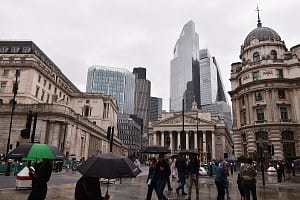The US Treasury yield curve inverted on Tuesday evening (UK time) for the first time since 2019, as investors priced in aggressive interest rate increases by the Federal Reserve as it attempts to bring inflation down from its highest levels in four decades.
In recent days, for the first time since the eve of the COVID19 pandemic, Treasury investors have been demanding almost the same return on longer-term debt as for shorter-term debt. This can indicate that bond investors think the US economy is in trouble in the medium term, as the Federal Reserve hikes rates in the short term to control inflation.
When the yields on longer-dated debt fall below those on short-dated debt, this is called an ‘inverted yield curve’ and has in the past been a reliable indicator that recession is looming on the horizon. However, current economic and policy circumstances might mean it’s different this time.
Here Adrian Lowery, analyst at investing platform Bestinvest, explains what it all means.
What’s happened now?
A closely watched section of the US Treasury (government bond) yield curve – the difference between yields on two and 10-year bonds – inverted last night for the first time since September 2019. Albeit briefly, the two-year yield exceeded that on 10-year dated debt by 0.03 of a basis point, before bouncing back above zero to five basis points, Reuters reported using data by Refinitiv.
Since the start of the year, the yields on short-dated debt have been soaring as bond traders bet on US Federal Reserve rate hikes. Futures traders expect the Fed’s benchmark rate to rise to 2.60% by February, compared to 0.33% today, according to Fedwatch data on Reuters.
What is the ‘yield curve’?
A yield curve is a chart that shows how the yields available from the same government issuer differ depending on the maturity period.
Typically, investors demand a higher return for holding longer-dated bonds (which are repayable in 10 to 30 years’ time) than for shorter-dated bonds (those that are repayable in three months to two years). This is because investors need greater reward for holding longer term investments, as the risks from inflation and default are greater over longer periods.
The difference between short-term and long-term yields – the yield curve – is therefore regarded as a good indicator of how confident the financial markets are about the future. Normally, the difference between shorter and longer terms yields is positive, and when it is growing, and the yield curve is steepening, this indicates a positive economic outlook.
So what is an inverted yield curve?
When investors become about the future, yield curves typical flatten. This has occurred recently with some Treasury yield curves, depending on which durations of debt are used as comparisons.
On rare occasions the difference between long-term yields and short-term yields becomes negative, so that long-term bonds pay less than short term debt. This indicates investors are expecting an economic downturn on the horizon that will force central bank interest rates to be cut – perhaps after initial, over-zealous hikes.
The yields on five-year Treasuries rose to 2.64% last week, while that on 30-year Treasuries fell to 2.58% – the first time that spread between the two has gone negative since 2006. The spread between two- and 10-year Treasuries had been narrowing towards zero but had not gone negative until now.
Why should we care?
Yield curve inversions have historically been a strong predictor of economic recessions. In fact, almost every time it has occurred over the last five decades, a recession has followed, and sometimes also a market downturn. Even the pandemic-induced recession of 2020 was preceded by a yield curve inversion.
So recession is on the way?
Not necessarily. First, the inversion was brief and very narrow – it will be closely watched to see what happens in the coming days. Bond prices and yields, like other financial assets, are seeing big swings on a daily basis at the moment given the continually evolving news flow.
Second, the other important spread between the yield on three-month Treasury bills and 10-year bonds has been widening this month, and is a long way from zero at 184 basis points, which does not suggest a recession is imminent.
Third, the Treasury yield curve has, some analysts argue, been distorted by quantitative easing: the Fed’s massive bond purchases are holding down long-dated yields relative to shorter-dated ones.
So, due to the complex range of circumstances – high levels of liquidity in the system from quantitative easing, economies emerging from lockdown, resurgent inflation and the Ukraine war – the usual rules might not apply. The inversion might signal for instance that investors believe inflation will stabilise in the long term, allowing rates to remain low – rather than rate cuts enforced by recession.





Leave a Comment